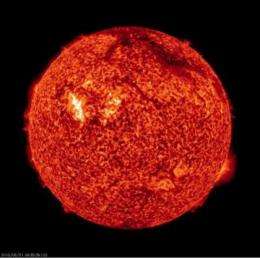Researchers create "MRI" of the Sun's interior motions

(Phys.org)—A team of scientists has created an "MRI" of the sun's interior plasma motions, shedding light on how it transfers heat from its deep interior to its surface. The result, which appeared in the journal the Proceedings of the National Academy of Sciences, upends our understanding of how heat is transported outwards by the sun and challenges existing explanations of the formation of sun spots and magnetic field generation.
The work was conducted by researchers from NYU's Courant Institute of Mathematical Sciences and its Department of Physics, Princeton University, the Max Planck Institute, and NASA.
The sun's heat, generated by nuclear fusion in its core, is transported to the surface by convection in the outer third. However, our understanding of this process is largely theoretical—the sun is opaque, so convection cannot be directly observed. As a result, theories largely rest on what we know about fluid flow and then applying them to the sun, which is primarily composed of hydrogen, helium, and plasma.
Developing a more precise grasp of convection is vital to comprehending a range of phenomena, including the formation of sun spots, which have a lower temperature than the rest of the sun's surface, and the sun's magnetic field, which is created by its interior plasma motions.
In order to develop their "MRI" of the sun's plasma flows, the researchers examined high-resolution images of the sun's surface taken by the Helioseismic and Magnetic Imager (HMI) onboard NASA's Solar Dynamics Observatory. Using a 16-million pixel camera, HMI measures motions on the sun's surface caused by convection.
Once the scientists captured the precise movement waves on the sun's surface, they were able to calculate its unseen plasma motions.
What they found significantly departed from existing theory—specifically, the speed of the sun's plasma motions were approximately 100 times slower than scientists had previously projected.
"Our current theoretical understanding of magnetic field generation in the sun relies on these motions being of a certain magnitude," explains Shravan Hanasoge, a research scholar at Princeton University and a visiting scholar at NYU's Courant Institute of Mathematical Sciences. "These convective motions are currently believed to prop up large-scale circulations in the outer third of the sun that generate magnetic fields."
"However, our results suggest that convective motions in the sun are nearly 100 times smaller than these current theoretical expectations," continued Hanasoge, also a postdoctoral fellow at the Max Planck Institute in Katlenburg-Lindau, Germany. "If these motions are indeed that slow in the sun, then the most widely accepted theory concerning the generation of solar magnetic field is broken, leaving us with no compelling theory to explain its generation of magnetic fields and the need to overhaul our understanding of the physics of the sun's interior."
Journal information: Proceedings of the National Academy of Sciences
Provided by New York University




















